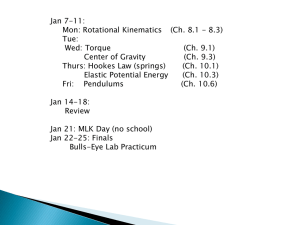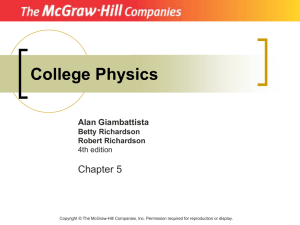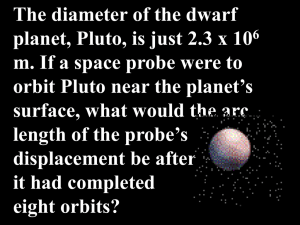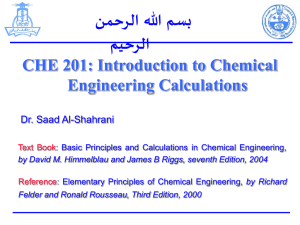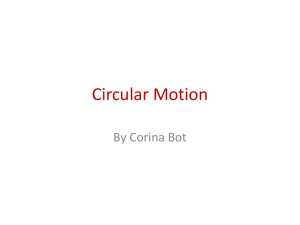Physics - Rotational Motion and Astrophysics
advertisement
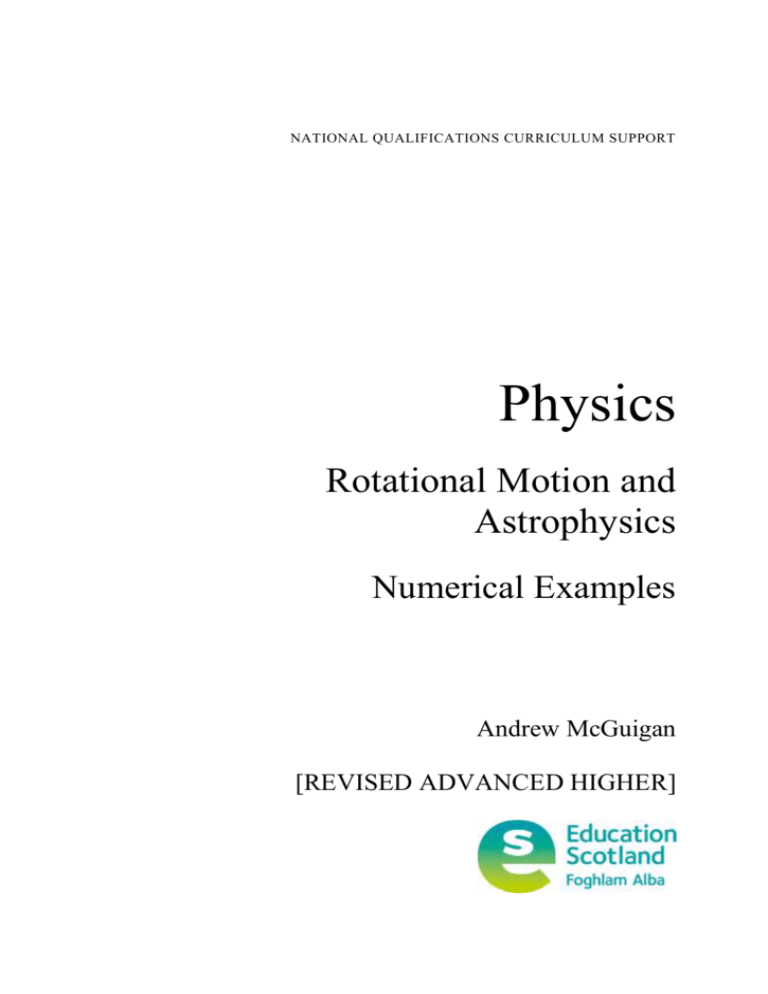
NATIONAL QUALIFICATIONS CURRICULUM SUPPORT Physics Rotational Motion and Astrophysics Numerical Examples Andrew McGuigan [REVISED ADVANCED HIGHER] The Scottish Qualifications Authority regularly reviews the arrangements for National Qualifications. Users of all NQ support materials, whether published by Education Scotland or others, are reminded that it is their responsibility to check that the support materials correspond to the requirements of the current arrangements. Acknowledgement © Crown copyright 2012. You may re-use this information (excluding logos) free of charge in any format or medium, under the terms of the Open Government Licence. To view this licence, visit http://www.nationalarchives.gov.uk/doc/open-government-licence/ or e-mail: psi@nationalarchives.gsi.gov.uk. Where we have identified any third party copyright information you will need to obtain permission from the copyright holders concerned. Any enquiries regarding this document/publication should be sent to us at enquiries@educationscotland.gov.uk. This document is also available from our website at www.educationscotland.gov.uk. 2 ROTATIONAL MOTION AND ASTROPHYSICS NUMERICAL EXAMPLES (AH, PHYSICS) © Crown copyright 2012 Contents Numerical questions Kinematic relationships Angular motion Centripetal force and acceleration Moment of inertia, torque and angular acceleration Angular momentum and rotational kinetic energy Gravitation Space and time Stellar physics 4 4 7 9 11 15 18 21 23 Numerical answers Kinematic relationships Angular motion Centripetal force and acceleration Moment of inertia, torque and angular acceleration Angular momentum and rotational kinetic energy Gravitation Space and time Stellar physics 27 27 28 29 29 30 31 32 33 ROTATIONAL MOTION AND ASTROPHYSICS NUMERICAL EXAMPLES (AH, PHYSICS) © Crown copyright 2012 3 NUMERICAL QUESTIONS Numerical questions Kinematic relationships 1. The displacement, s, in metres, of an object after time t in seconds, is given by s = 90t – 4t 2 . (a) (b) (c) 2. 3. Using a calculus method, find an expression for the object’s velocity. At what time will the velocity be zero? Show that the acceleration is constant and state its value. The displacement, s, in metres of a 3 kg mass is given by s = 8 – 10t + t 2 , where t is the time in seconds. (a) Calculate the object’s velocity after: (i) 2s (ii) 5 s (iii) 8 s. (b) (c) Calculate the unbalanced force acting on the object after 4 s. Comment on the unbalanced force acting on the object during its journey. The displacement, s, of a car is given by the expression s = 5t + t 2 metres, where t is in seconds. Calculate: (a) the velocity of the car when the timing started (b) the velocity of the car after 3 seconds (c) the acceleration of the car (d) the time taken by the car to travel 6 m after the timing started. 4. The displacement, s, of an object is given by the expression s = 3t 3 + 5t metres, where t is in seconds. (a) (b) 4 Calculate the displacement, speed and acceleration of the object after 3 seconds. Explain why the unbalanced force on the object is not constant. ROTATIONAL MOTION AND ASTROPHYSICS NUMERICAL EXAMPLES (AH, PHYSICS) © Crown copyright 2012 NUMERICAL QUESTIONS 5. An arrow is fired vertically in the air. The vertical displacement, s, is given by s = 34.3t – 4.9t 2 metres, where t is in seconds. (a) (b) (c) (d) 6. The displacement, s, of an object is given by s = 12 + 15t 2 – 25t 4 metres, where t is in seconds. (a) (b) (c) 7. Calculate the speed of the rocket after 15 seconds. How far had the rocket travelled in 30 s? Suggest a reason why the expression for displacement is only valid for the first 30 s. A box with a constant acceleration of 4 m s –2 slides down a smooth slope. At time t = 0 the displacement of the box is 2 m and its velocity is 3 m s –1 . (a) (b) 9. Find expressions for the velocity and acceleration of the object. Determine the object’s initial: (i) displacement (ii) velocity (iii) acceleration. At what times is the velocity of the object zero? The displacement, s, of a rocket launched from the Earth’s surface is given by s = 2t 3 + 8t 2 metres for 0 ≤ t ≤ 30 seconds. (a) (b) (c) 8. Find an expression for the velocity of the arrow. Calculate the acceleration of the arrow. Calculate the initial velocity of the arrow. Calculate the maximum height reached by the arrow. Use a calculus method to show that the velocity v of the box is given the expression v = 4t + 3 m s –1 . Show that the displacement of the box is given by s = 2t 2 + 3t + 2 metres. The velocity, v, of a moving trolley is given by v = 6t + 2 m s –1 . The displacement of the trolley is zero at time t = 0. (a) (b) (c) Derive an expression for the displacement of the trolley. Calculate the acceleration of the trolley. State the velocity of the trolley at time t = 0. ROTATIONAL MOTION AND ASTROPHYSICS NUMERICAL EXAMPLES (AH, PHYSICS) © Crown copyright 2012 5 NUMERICAL QUESTIONS 10. The following graph shows the displacement of an object varying with time. displacement (m) time (s) Calculate the velocity of the object at: (a) 3 s (b) 8 s (c) 12 s. 11. The following graph shows how the velocity of an object cha nges with time. velocity (m s –1 ) time (s) (a) (b) (c) 6 Calculate the acceleration of the object at 2 s. At what time is the acceleration zero? Estimate the distance travelled between 2 s and 5 s. ROTATIONAL MOTION AND ASTROPHYSICS NUMERICAL EXAMPLES (AH, PHYSICS) © Crown copyright 2012 NUMERICAL QUESTIONS Angular motion 1. Convert the following from degrees into radians : 180°, 360°, 90°, 60°, 30°, 14°, 1° 2. Convert the following from radians to degrees: π rad, 2π rad, ½π rad, 1 rad, 5 rad, 0.1 rad, 0.01 rad 3. Calculate the angular velocity of each of the following: (a) (b) (c) (d) (e) (f) (g) (h) 4. A propeller rotates at 95 rpm. (a) (b) 5. A bicycle spoke turning through 5.8 rad in 3.6 s. A playground roundabout rotating once every 4 s. An electric drill bit rotating at 3000 revo lutions per minute (rpm). An electric drill bit rotating at 40 revolutions per second. The second hand of an analogue watch. The Moon orbiting the Earth with a period of 27.3 days. The Earth spinning about its polar axis. A rotating object whose angular displacement, θ, is given by θ = 5t + 4 radians, where t is the time in seconds. Calculate the angular velocity of the propeller. Each propeller blade has a length of 0.35 m. Calculate the linear speed of the tip of a propeller. A CD of diameter 120 mm rotates inside a CD player. •A The linear speed of point A on the circumference of the CD is 1.4 m s –1 . Calculate the angular velocity of the CD: (a) (b) 6. in rad s –1 in rpm. A rotating disc accelerates uniformly from 1.5 rad s –1 to 7.2 rad s –1 in 4 s. (a) (b) (c) Calculate the angular acceleration of the disc. Calculate the total angular displacement in this time. How many revolutions does the disc make in this time? ROTATIONAL MOTION AND ASTROPHYSICS NUMERICAL EXAMPLES (AH, PHYSICS) © Crown copyright 2012 7 NUMERICAL QUESTIONS 7. A washing machine drum slows down uniformly from 900 r pm to rest in 15 s. (a) (b) 8. A bicycle wheel rotating at 300 rpm makes 120 complete revolutions as it slows down uniformly and comes to rest. (a) (b) 9. Calculate the angular acceleration of the drum. How many revolutions does the drum make in this time? Calculate the angular acceleration of the wheel. Calculate the time taken by the wheel to stop. The graph shows how the angular velocity of a rotating drum varies with time. 12 ω (rad s –1- ) 0 (a) (b) (c) 8 4 10 16 time (s) Calculate the initial and final angular acceleration of the drum. Calculate the total angular displacement of the drum. How many revolutions does the drum make in 16 s? ROTATIONAL MOTION AND ASTROPHYSICS NUMERICAL EXAMPLES (AH, PHYSICS) © Crown copyright 2012 NUMERICAL QUESTIONS Centripetal force and acceleration 1. A mass of 150 g is attached to a string of length 1.2 m. The string is used to whirl the mass in a horizontal circle at two revolutions per second. (a) (b) (c) 2. Calculate the centripetal acceleration of the mass. Calculate the centripetal (central) force acting on the mass. The string has a breaking force of 56 N. Calculate the maximum angular velocity of the mass. A mass of 0.50 kg is attached to a string of length 0.45 m and rotated in a horizontal circle. The mass has a linear (tangential) speed of 7.6 m s –1 . Calculate the tension in the string. 3. A 3.0 kg mass attached to a string of length 0.75 m rotates in a vertical circle with a steady speed of 8.0 m s –1 . (a) (b) (c) 4. In a space flight simulator an astronaut is rotated horizontally at 20 rpm in a pod on the end of a radius arm of length 5.0 m. The mass of the astronaut is 75 kg. (a) (b) (c) 5. Calculate the tension in the string when the mass is at the top of the circle. Calculate the tension in the string when the mass is at the bottom of the circle. Calculate the minimum speed required for the mass to move in this vertical circle. Calculate the central force on the astronaut. Show that this force is equivalent to a gravitational force of 2.2 g. Calculate the rotation rate in rpm that would give a ‘simulated’ gravity of 3 g. A wet cloth of mass 50 g rotates at 1200 rpm in a spin-dryer drum of diameter 0.45 m. Calculate the central force acting on the cloth. ROTATIONAL MOTION AND ASTROPHYSICS NUMERICAL EXAMPLES (AH, PHYSICS) © Crown copyright 2012 9 NUMERICAL QUESTIONS 6. A small object of mass m revolves in a horizontal circle at a constant speed on the end of a string. 30° 1.2 m The string has a length of 1.2 m and makes an angle of 30 ° to the vertical as the mass rotates. (a) (b) (c) (d) (e) (f) (g) 10 Name the two forces acting on the mass and draw a diagram showing the two forces acting on the mass. Resolve the tension T in the string into a horizontal component and a vertical component. (i) Which component of the tension balances the weight of mass m? (ii) Write down an equation which describes this component. (i) Which component of the tension provides the central force to keep the mass moving in a circle? (ii) Write down an equation using the central force and one of the components of the tension. Calculate the radius of the circle using trigonometry. Calculate the linear speed of the mass. Calculate the period of the motion. ROTATIONAL MOTION AND ASTROPHYSICS NUMERICAL EXAMPLES (AH, PHYSICS) © Crown copyright 2012 NUMERICAL QUESTIONS Moment of inertia, torque and angular acceleration 1. Calculate the moment of inertia of: (a) a disc of mass 2.3 kg and radius 0.75 m rotating about this axis axis (b) (c) (d) (e) (f) (g) a rod of mass 0.45 kg and length 0.6 m rotating about its centre a rod of mass 1.2 kg and length 0.95 m rotating about its end a sphere of mass 12 kg and radius 0.15 m about an axis through its centre a point mass of 8.5 × 10 –2 kg rotating 7.5 × 10 –2 m from the rotation axis a metal ring of mass 2.1 kg and radius 0.16 m rotating about its central axis of symmetry a solid cylinder of mass 4.5 kg and diameter 0.48 m rotating about the axis shown. axis ROTATIONAL MOTION AND ASTROPHYSICS NUMERICAL EXAMPLES (AH, PHYSICS) © Crown copyright 2012 11 NUMERICAL QUESTIONS 2. A wheel can be represented by a rim and five spokes. The rim has a mass of 1.5 kg and each spoke has a length of 0.55 m and mass of 0.32 kg. Calculate the moment of inertia of the wheel, assuming rotation about its axle (dotted line). 3. Calculate the torque applied about the axis in each of the following (the axis of rotation is represented by ): Disc diameter = 3.2 m 6 cm Axis 28 cm 18 cm 4 kg 15 N (a) 4. 25 N (b) (c) Calculate the torque applied by the 16 N force to the disc of radius 120 mm rotating about the axis represented by . 16 N 30° 5. An engineer using a spanner of length 22 cm applies a torque of 18 N m to a nut. Calculate the force exerted by the engineer. 12 ROTATIONAL MOTION AND ASTROPHYSICS NUMERICAL EXAMPLES (AH, PHYSICS) © Crown copyright 2012 NUMERICAL QUESTIONS 6. A flywheel has a moment of inertia of 1.2 kg m 2 and is acted on by an unbalanced torque of 0.80 N m. (a) (b) Calculate the angular acceleration of the flywheel. The unbalanced torque acts for 5 s and the flywheel starts from rest. Calculate: (i) the angular velocity at the end of the 5 s (ii) the number of revolutions made in the 5 s. 7. A hoop of mass 0.25 kg and radius 0.20 m rotates about its central axis. Calculate the torque required to give the hoop an angular acceleration of 5.0 rad s –2 . 8. A solid drum has a moment of inertia of 2.0 kg m 2 and radius 0.50 m. The drum rotates freely about its central axis at 10 rev s –1 . A constant frictional force of 5.0 N is exerted tangentially to the rim of the drum. Calculate: (a) the time taken for the drum to come to rest (b) the number of revolutions made during the braking period (c) the heat generated during the braking. 9. A flywheel, with a moment of inertia of 1.5 kg m 2 , is driven by an electric motor which provides a driving torque of 7.7 N m. The flywheel rotates with a constant angular velocity of 52 rad s –1 . (a) (b) 10. State the frictional torque acting on the flywheel. Give a reason for your answer. The electric motor is now switched off. Calculate the time taken for the flywheel to come to rest. State any assumption you have made. A cylindrical solid drum has a rope of length 5.0 m wound round it . The rope is pulled with a constant force of 8.0 N and the drum is free to rotate about its central axis as shown. Axis 8.0 N ROTATIONAL MOTION AND ASTROPHYSICS NUMERICAL EXAMPLES (AH, PHYSICS) © Crown copyright 2012 13 NUMERICAL QUESTIONS The radius of the drum is 0.30 m and its moment of inertia about the axis is 0.40 kg m 2 . (a) (b) (c) 11. Calculate the torque applied to the drum. Calculate the angular acceleration of the drum, ignoring any frictional effects. Calculate the angular velocity of the drum just as the rope leaves the drum, assuming the drum starts from rest. A bicycle wheel is mounted so that it can rotate horizontally as shown. The wheel has a mass of 0.79 kg and radius of 0.45 m, and the masses of the spokes and axle are negligible. (a) (b) (c) (d) (e) Show that the moment of inertia of the wheel is 0 .16 kg m 2 . A constant driving force of 20 N is applied tangentially to the rim of the wheel. Calculate the magnitude of the driving torque on the wheel. A constant frictional torque of 1.5 N m acts on the wheel. Calculate the angular acceleration of the wheel. After a period of 4 s, and assuming the wheel starts from rest, calculate: (i) the total angular displacement of the wheel (ii) the angular velocity of the wheel (iii) the kinetic energy of the wheel. The driving force is removed after 4 s. Calculate the time taken for the wheel to come to rest. 12. A playground roundabout has a moment of inertia of 500 kg m 2 about its axis of rotation. 14 ROTATIONAL MOTION AND ASTROPHYSICS NUMERICAL EXAMPLES (AH, PHYSICS) © Crown copyright 2012 NUMERICAL QUESTIONS A constant torque of 200 N m is applied tangentially to the rim of the roundabout. (a) (b) (c) The angular acceleration of the roundabout is 0.35 rad s –2 . Show that the frictional torque acting on the roundabout is 25 N m. A child of mass 50 kg sits on the roundabout at a distance of 1.25 m from the axis of rotation and the 200 N m torque is reapplied. Calculate the new angular acceleration of the roundabout. The 200 N m torque in part (b) is applied for 3 s then removed. (i) Calculate the maximum angular velocity of the roundabout and child. (ii) The 200 N m torque is now removed. Find the time taken by the roundabout and child to come to rest. Angular momentum and rotational kinetic energy 1. A bicycle wheel has a moment of inertia of 0.25 kg m 2 about its axle. The wheel rotates at 120 rpm. Calculate: (a) (b) 2. the angular momentum of the wheel the rotational kinetic energy of the wheel. A turntable of moment of inertia 5.8 × 10 –2 kg m 2 rotates freely at 3.5 rad s –1 with no external torques. A small mass of 0.18 kg falls vertically onto the turntable at a distance of 0.16 m from the axis of rotation. 0.16 m Calculate the new angular speed of the turntable. 3. A turntable rotates freely at 40 rpm about its vertical axis. A small mass of 50 g falls vertically onto the turntable at a distance of 80 mm from the central axis. The rotation of the turntable is reduced to 33 rpm. Calculate the moment of inertia of the turntable. ROTATIONAL MOTION AND ASTROPHYSICS NUMERICAL EXAMPLES (AH, PHYSICS) © Crown copyright 2012 15 NUMERICAL QUESTIONS 4. A CD of mass 0.020 kg and diameter 120 mm is dropped onto a turntable rotating freely at 3.0 rad s –1 . The turntable has a moment of inertia of 5.0 × 10 –4 kg m 2 about its rotation axis. (a) (b) 5. Calculate the angular speed of the turntable after the CD lands on it. Assume the CD is a uniform disc with no hole in the centre. Will your answer to part (a) be bigger, smaller or unchanged if the hole in the centre of the CD is taken into account? Explain your answer. A turntable rotates freely at 100 rpm about its central axis . The moment of inertia of the turntable is 1.5 × 10 –4 kg m 2 about this axis. A mass of plasticine is dropped vertically onto the turntable and sticks at a distance of 50 mm from the centre of the turntable. 50 mm The turntable slows to 75 rpm after the plastic ine lands on it. Calculate the mass of the plasticine. 6. An ice skater is spinning with an angular velocity of 3 .0 rad s –1 with her arms outstretched. The skater draws in her arms and her angular velocity increases to 5.0 rad s –1 . (a) 16 Explain why the angular velocity increases. ROTATIONAL MOTION AND ASTROPHYSICS NUMERICAL EXAMPLES (AH, PHYSICS) © Crown copyright 2012 NUMERICAL QUESTIONS (b) (c) (d) 7. When the skater’s arms are outstretched her moment of inertia about the spin axis is 4.8 kg m 2 . Calculate her moment of inertia when her arms are drawn in. Calculate the skater’s change in rotational kinetic energy. Explain why there is a change in kinetic energy. A solid sphere of mass 5.0 kg and radius 0.40 m rolls along a horizontal surface without slipping. The linear speed of the sphere as it passes point A is 1.2 m s –1 . A As the sphere passes point A calculate: (a) (b) (c) (d) 8. the the the the linear kinetic energy of the sphere angular velocity of the sphere rotational kinetic energy of the sphere total kinetic energy of the sphere. A solid cylinder of mass 3.0 kg and radius 50 mm rolls down a slope without slipping. 0.60 m 40° The slope has a length of 0.60 m and is inclined at 40° to the horizontal. (a) (b) Calculate the loss in gravitational potential ene rgy as the cylinder rolls from the top to the bottom of the slope. Calculate the linear speed of the cylinder as it reaches the bottom of the slope. ROTATIONAL MOTION AND ASTROPHYSICS NUMERICAL EXAMPLES (AH, PHYSICS) © Crown copyright 2012 17 NUMERICAL QUESTIONS Gravitation Astronomical data: mass of Earth radius of Earth mean radius of Earth orbit mass of Moon radius of Moon mean radius of Moon orbit mass of Mars radius of Mars mass of Sun = = = = = = = = = 6.0 × 10 24 kg 6.4 × 10 6 m 1.5 × 10 11 m 7.3 × 10 22 kg 1.7 × 10 6 m 3.84 × 10 8 m 6.4 × 10 23 kg 3.4 × 10 6 m 2.0 × 10 30 kg 1. Calculate the gravitational force between two cars each of mass 1000 kg and parked 0.5 m apart. 2. Two large ships, each of mass 5.0 × 10 4 tonnes, are separated by a distance of 20 m. Show that the force of attraction between them is 417 N (1 tonne = 1000 kg). 3. Calculate the force of attraction between the Earth and the Sun. 4. The gravitational field strength at the surface of the Earth is 9.8 N kg –1 . Calculate the mass of the Earth. 5. Calculate the gravitational field strength on the surface of : (a) Mars (b) the Moon. 6. The gravitational field strength changes with altitude above sea level. Calculate the gravitational field strength at these locations: (a) (b) (c) (d) at the summit of Ben Nevis (height 1344 m) at the summit of Mount Everest (height 8848 m) on board an aircraft cruising at 12000 m on board the International Space Station orbiting at 350 km above the Earth. 7. A satellite of mass m orbits a planet of mass M and radius R. (a) Show that the time for one complete orbit T (called the period of the satellite) is given by the expression 4π 2 3 T2 R GM Is the time T dependent on the mass of the satellite? 18 ROTATIONAL MOTION AND ASTROPHYSICS NUMERICAL EXAMPLES (AH, PHYSICS) © Crown copyright 2012 NUMERICAL QUESTIONS 8. A satellite orbits the Earth at a height of 250 km above the Earth’s surface. (a) (b) Calculate the radius of the orbit of this satellite. Calculate the time taken by the satellite to make one orbit of the Earth. 9. A satellite orbits the Earth with a period of 95 min. Calculate the height of the satellite above the Earth’s surface. 10. A geostationary satellite of mass 250 kg orbits the Earth above the Equator. (a) (b) (c) (d) State the period of the orbit. Calculate the height of the satellite above the Equator. Calculate the linear speed of the satellite. Calculate the centripetal force acting on the geostationary satellite. 11. The Moon is a satellite of the Earth. Calculate the period of the Moon’s orbit in days. 12. Show by calculation that the Earth takes approximately 365 days to orbit the Sun. 13. The table shows some information about four of Saturn’s moons . Moon name Mean orbit radius R (km) Orbit period T (days) Titan 1.22 × 10 6 Rhea 5.27 × 10 5 Dione 3.77 × 10 5 Enceladus 2.38 × 10 5 16 4.5 2.7 1.37 Show that T 2 is directly proportional to R 3 . 14. Calculate the gravitational potential at a point: (a) (b) (c) on the Earth’s surface 800 km above the Earth’s surface 100 km above the Moon’s surface. ROTATIONAL MOTION AND ASTROPHYSICS NUMERICAL EXAMPLES (AH, PHYSICS) © Crown copyright 2012 19 NUMERICAL QUESTIONS 15. Calculate the gravitational potential energy of: (a) a 250 kg rocket on the Earth’s surface (b) a 500 kg satellite orbiting 350 km above the Earth’s surface (c) a 75 kg astronaut on the surface of the Moon. 16. A satellite of mass 450 kg has a gravitational potential energy of –2.3 × 10 10 J. Calculate the height of the satellite above the Earth’s surface. 17. A geostationary satellite of mass 2000 kg orbits 3.6 × 10 7 m above the Earth’s surface. Calculate: (a) the gravitational potential energy of the satellite (b) the kinetic energy of the satellite (c) the total energy of the satellite. 18. A satellite of mass 270 kg orbits the Earth at a height of 320 km above the Earth’s surface. Calculate the energy required to change the satellite’s orbit to a height of 460 km above the Earth’s surface. 19. A satellite of mass m orbits a planet of mass M with a radius of R. 1 GMm Show that the total energy of the satellite in orbit is – 2 R 20. Derive an expression for the escape velocity from a planet in terms of the mass m and radius r of the planet. 21. Calculate the escape velocity from the surface of: (a) (b) (c) the Earth the Moon Mars. 22. Calculate the escape velocity for a satellite that is in orbit 550 km above the Earth’s surface. 23. The escape velocity from the surface of the Moon is 2.4 × 10 3 m s –1 . (a) 20 An object is projected from the surface of the Moon with a speed of 2.0 × 10 3 m s –1 . Calculate the maximum height reached above the Moon’s surface. ROTATIONAL MOTION AND ASTROPHYSICS NUMERICAL EXAMPLES (AH, PHYSICS) © Crown copyright 2012 NUMERICAL QUESTIONS (b) An object is projected from the surface of the Moon with a speed of 2.8 × 10 3 m s –1 . Calculate the speed of the object after it le aves the Moon’s gravitational field. Space and time 1. What is meant by an inertial frame of reference? 2. What is meant by a non-inertial frame of reference? 3. Which frame of reference applies to the theory of special relativity (studied in Higher Physics)? 4. At what range of speeds do the results obtained by the theory of special relativity agree with those of Newtonian mechanics? 5. How does the equivalence principle link the effects of gravity with acceleration? 6. In which part of an accelerating spacecraft doe s time pass more slowly? 7. Does time pass more quickly or more slowly at high altitude in a gravitational field? 8. How many dimensions are normally associated with space -time? 9. Two space-time diagrams are shown, with a worldline on each. Write down what each of the worldlines describes. t t x x (a) 10. (b) The space-time diagram shows two worldlines. Which worldline describes a faster speed? (These speeds are much less than the speed of light.) t x ROTATIONAL MOTION AND ASTROPHYSICS NUMERICAL EXAMPLES (AH, PHYSICS) © Crown copyright 2012 21 NUMERICAL QUESTIONS 11. Explain the difference between these two worldlines on the space-time diagram. t x 12. Explain what is meant by the term geodesic. 13. Copy the following space-time diagram. t x Insert the following labels onto your diagram: the present the future the past v=c v˂c v ˃ c. 14. What effect does mass have on spacetime? 15. Describe two situations where a human body experiences the sensation of force. 16. How does general relativity interpret the cause of gravity? 17. Mercury’s orbit around the Sun could not be predicted accurately using classical mechanics. General relativity was able to predict Mercury’s orbit accurately. Investigate this using a suitable search engine and write a short paragraph summarising your results. 18. A star of mass 4.5 × 10 31 kg collapses to form a black hole. Calculate the Schwarzschild radius of this black hole. 22 ROTATIONAL MOTION AND ASTROPHYSICS NUMERICAL EXAMPLES (AH, PHYSICS) © Crown copyright 2012 NUMERICAL QUESTIONS 19. A star of mass equivalent to six solar masses collapses to form a black hole. Calculate the Schwarzschild radius of this black hole. 20. If our Sun collapsed to form a black hole, what would be the Schwarzschild radius of this black hole? 21. If our Earth collapsed to form a black hole, what would be the Schwarzschild radius of this black hole? 22. A star is approximately the same size as our Sun and has an average density of 2.2 × 10 3 kg m –3 . If this star collapsed to form a black hole, calculate the Schwarzschild radius of the black hole. Stellar physics 1. A star emits electromagnetic radiation with a peak wavelength of 6.8 × 10 –7 m. (a) (b) 2. The Sun has a radius of 7.0 × 10 8 m and a surface temperature of 5800 K. (a) (b) (c) 3. Use Wien’s law (λ max T = 3 × 10 –3 ) to calculate the surface temperature of the star. Calculate the power of the radiation emitted by each square metre of the star’s surface where the star is assumed to be a black body. Stefan–Boltzmann constant = 5.67 × 10 –8 J s –1 m –2 K –4 . Calculate the power emitted per m 2 from the Sun’s surface. Calculate the luminosity of the Sun. Calculate the apparent brightness of the Sun as seen from the Earth. Three measurements of a distant star are possible from Earth. These measurements are: apparent brightness = 4.3 × 10 –9 W m–2 peak emitted wavelength = 2.4 × 10 –7 m distance to star (parallax method) = 8.5 × 10 17 m (a) Use Wien’s law (λ max T = 3 × 10 –3 ) to calculate the surface temperature of the star. (b) Calculate the energy emitted by each square metre of the star’s surface per second. ROTATIONAL MOTION AND ASTROPHYSICS NUMERICAL EXAMPLES (AH, PHYSICS) © Crown copyright 2012 23 NUMERICAL QUESTIONS (c) (d) Calculate the luminosity of the star. Calculate the radius of the star. 4. A star is 86 ly from Earth and has a luminosity of 4.8 × 10 28 W m –2 . Calculate the apparent brightness of the star. 5. The apparent brightness of a star is 6.2 × 10 –8 W m –2 . The star is 16 ly from Earth. Calculate the luminosity of the star. 6. A star with luminosity 2.1 × 10 30 W m –2 has an apparent brightness of 7.9 × 10 –8 W m –2 when viewed from Earth. Calculate the distance of the star from Earth: (a) in metres (b) in light years. 7. A star with radius 7.8 × 10 8 m and surface temperature 6300 K has an apparent brightness of 1.8 × 10 –8 W m –2 . Calculate its distance from the Earth. 8. A star with radius 9.5 × 10 9 m and surface temperature 5900 K is 36 ly from Earth. Calculate the apparent brightness of the star. 9. Show mathematically that the luminosity of a star varies directly with the square of its radius and the fourth power of its surface temperature. 10. Show mathematically that the apparent brightness of a star varies directly with the square of its radius and the fourth power of its surface temperature and varies inversely with the square of its distance from the Earth. 11. Two stars, A and B, are the same distance from the Earth. The apparent brightness of star A is 8.0 × 10 –12 W m –2 and the apparent brightness of star B is 4.0 × 10 –13 W m –2 . Show that star A has 20 times the luminosity of star B. 12. A star has half of our Sun’s surface temperature and 400 times our Sun’s luminosity. How many times bigger is the radius of this star compared to the Sun? 13. Information about two stars A and B is given below. surface temperature of star radius of star 24 A = 3 × surface temperature of star B A = 2 × radius of star B ROTATIONAL MOTION AND ASTROPHYSICS NUMERICAL EXAMPLES (AH, PHYSICS) © Crown copyright 2012 NUMERICAL QUESTIONS (a) (b) 14. How many times is the luminosity of star A greater than the luminosity of star B? Stars A and B have the same apparent brightness from Earth. Which star is furthest from Earth and by how many times? The diagram shows one way of classifying stars. Each dot on the diagram represents a star. units (a) (b) What name is usually given to this type of diagram? The stars are arranged into four main regions. Identify the region called: (i) the main sequence (ii) giants (iii) super giants (iv) white dwarfs. (c) (i) (ii) (d) In which of the regions on the diagram is the Sun? The surface temperature of the Sun is approximately 5800 K. Explain why the scale on the temperature axis makes it difficult to identify which dot represents the Sun. In which region would you find the following: (i) a hot bright star (ii) a hot dim star (iii) a cool bright star (iv) a cool dim star? ROTATIONAL MOTION AND ASTROPHYSICS NUMERICAL EXAMPLES (AH, PHYSICS) © Crown copyright 2012 25 NUMERICAL QUESTIONS (e) (f) (g) 26 A star is cooler than, but brighter than the Sun. (i) What can be deduced about the size of this star compared to the size of the Sun? (ii) What region would this star be in? A star is hotter than, but dimmer than, the Sun. (i) What can be deduced about the size of this star compared to the size of the Sun? (ii) What region would this star be in? The Sun’s nuclear fuel will be used up with time. What will then happen to the Sun’s position in the above d iagram? ROTATIONAL MOTION AND ASTROPHYSICS NUMERICAL EXAMPLES (AH, PHYSICS) © Crown copyright 2012 NUMERICAL ANSWERS Numerical answers Kinematic relationships 1. (a) (b) (c) 90 – 8t 11.25 s –8 m s –2 2. (a) (b) (c) (i) –6 m s –1 (ii) 0 (iii) 6 m s –1 6N Constant 3. (a) (b) (c) (d) 5 m s –1 11 m s –1 2 m s –2 1s 4. (a) (b) 96 m; 86 m s –1 ; 54 m s –2 a depends on time t 5. (a) (b) (c) (d) v = 34.3 – 9.8t –9.8 m s –2 34.3 m s –1 60 m 6. (a) (b) (c) v = 30t – 100t 3 ; a = 30 – 300t 2 (i) 12 m (ii) 0 (iii) 30 m s –2 0 s and 0.55 s (a) (b) (c) 1590 m s –1 61200 m The rocket runs out of fuel. 7. ROTATIONAL MOTION AND ASTROPHYSICS NUMERICAL EXAMPLES (AH, PHYSICS) © Crown copyright 2012 27 NUMERICAL ANSWERS 9. (a) (b) (c) s = 3t 2 + 2t 6 m s –2 2 m s –1 10. (a) (b) (c) 1.67 m s –1 Zero –1.25 m s –1 (gradient of tangent to slope at 12 s) 11. (a) (b) (c) –3.2 m s –2 4s (or 4.1 s) Approx. 8.75 m (17½ boxes) Angular motion 1. 3.14 rad; 6.28 rad; 1.57 rad; 1.047 rad; 0.52 rad; 0.244 rad; 0.0174 rad 2. 180°; 360° 90°; 57.3°; 287°; 5.7°; 0.57° 3. (a) (b) (c) (d) (e) (f) (g) (h) 1.6 rad s –1 1.57 rad s –1 314 rad s –1 251 rad s –1 0.105 rad s –1 2.67 × 10 –6 rad s –1 7.27 × 10 –5 rad s –1 5 rad s –1 4. (a) (b) 9.9 rad s –1 3.5 m s –1 5. (a) (b) 23.3 rad s –1 223 rpm 6. (a) (b) (c) 1.4 rad s –2 17.4 rad 2.8 revolutions 7. (a) (b) –6.28 rad s –2 112.5 revolutions 8. (a) (b) –0.65 rad s –2 48 s 28 ROTATIONAL MOTION AND ASTROPHYSICS NUMERICAL EXAMPLES (AH, PHYSICS) © Crown copyright 2012 NUMERICAL ANSWERS 9 (a) (b) (c) 3 rad s –2 , –2 rad s –2 132 rad 21 revolutions Centripetal force and acceleration 189 m s –2 28.4 N 17.6 rad s –1 1. (a) (b) (c) 2. 64 N 3. (a) (b) (c) 227 N 285 N 2.7 m s –1 4. (a) (b) (c) 1643 N 21.9 = 2.2 × 9.8 23 rpm 5. 177 N 6. (a) (b) (c) (d) (e) (f) (g) Weight of mass, tension in string Horizontal component = T sin30; vertical component = T cos30 (i) T cos30 (ii) T cos30 = mg (i) T sin30 (ii) T sin30 = mv 2 /r 0.6 m 1.84 m s –1 2.0 s Moment of inertia, torque and angular acceleration 1. (a) (b) (c) (d) (e) (f) (g) 0.65 kg m 2 1.35 × 10 –2 kg m 2 0.36 kg m 2 0.108 kg m 2 4.8 × 10 –4 kg m 2 0.045 kg m 2 0.13 kg m 2 ROTATIONAL MOTION AND ASTROPHYSICS NUMERICAL EXAMPLES (AH, PHYSICS) © Crown copyright 2012 29 NUMERICAL ANSWERS 2. 0.61 kg m 2 3. (a) (b) (c) 4. 1.7 N m 5. 81.8 N 6. (a) (b) 7. 0.05 N m 8. (a) (b) (c) 50 s 251 revolutions 3.9 × 10 3 J 9. (a) (b) 7.7 N m (steady rotational speed, torques balanced) 10 s (frictional torque stays constant) 10. (a) (b) (c) 2.4 N m 6 rad s –2 14 rad s –1 11. (a) (c) (d) 9.0 N m 46.9 rad s –2 (i) 375 rad (ii) 188 rad s –1 (iii) 2.8 × 10 3 J 20 s (e) 12. (b) (c) 4.2 N m 3.0 N m 63 N m 0.67 rad s –2 (i) 3.3 rad s –1 (ii) 1.33 revolutions 0.30 rad s –2 (i) 0.9 rad s –1 (ii) 20.9 s Angular momentum and rotational kinetic energy 3.14 kg m 2 rad s –1 (or units could be kg m 2 s –1 ) 19.7 J 1. (a) (b) 2. 3.2 rad s –1 30 ROTATIONAL MOTION AND ASTROPHYSICS NUMERICAL EXAMPLES (AH, PHYSICS) © Crown copyright 2012 NUMERICAL ANSWERS 3. 1.5 × 10 –3 kg m 2 4. (a) (b) 5. 0.02 kg 6. (a) (b) (c) (d) Her I decreases, so ω increases, as L is conserved. 2.9 kg m 2 14.7 J increase Supplied by skater’s body (chemical energy). 7. (a) (b) (c) (d) 3.6 J 3 rad s –1 1.44 J 5.04 J 8. (a) (b) 11.3 J 2.24 m s –1 2.8 rad s –1 I CD will be bigger as more mass further from axis, angular velocity less. Gravitation 1. 2.7 × 10 –4 N 3. 3.56 × 10 22 N 4. 6.02 × 10 24 kg 5. (a) (b) 3.7 N kg –1 1.7 N kg –1 6. (a) (b) (c) (d) 9.77 N kg –1 9.74 N kg –1 9.73 N kg –1 8.8 N kg –1 7. No 8. (a) (b) 9. 508 km 6.65 × 10 6 m 90 minutes ROTATIONAL MOTION AND ASTROPHYSICS NUMERICAL EXAMPLES (AH, PHYSICS) © Crown copyright 2012 31 NUMERICAL ANSWERS 10. (a) (b) (c) (d) 24 h 3.6 × 10 7 m 3.1 × 10 3 m s –1 57 N 11. 27.3 days 13. T 2 /R 3 = 1.4 × 10 –16 (constant) for all four moons 14. (a) (b) (c) –6.25 × 10 7 J kg –1 –5.56 × 10 7 J kg –1 –2.7 × 10 6 J kg –1 15. (a) (b) (c) –1.56 × 10 10 J –3.0 × 10 10 J –2.15 × 10 8 J 16. 1.43 × 10 6 m 17. (a) (b) (c) 18. 1.6 × 10 8 J needed 21. (a) (b) (c) 22. 1.07 × 10 4 m s –1 23. (a) (b) –1.9 × 10 10 J 9.5 × 10 9 J –9.5 × 10 9 J 1.12 × 10 4 m s –1 2.4 × 10 3 m s –1 5.0 × 10 3 m s –1 3.9 × 10 6 m 1.45 × 10 3 m s –1 Space and time 18. 6.67 × 10 4 m 19. 1.8 × 10 4 m 20. 3000 m 21. 8.9 × 10 –3 m (8.9 mm) 32 ROTATIONAL MOTION AND ASTROPHYSICS NUMERICAL EXAMPLES (AH, PHYSICS) © Crown copyright 2012 NUMERICAL ANSWERS 22. 4.7 × 10 3 m Stellar physics 1. (a) (b) 4410 K 2.1 × 10 7 W m–2 2. (a) (b) (c) 6.42 × 10 7 W m–2 3.95 × 10 26 W 1.4 × 10 3 W m2 3. (a) (b) (c) (d) 12500 K 1.38 × 10 9 J (m–2 s –1 ) 3.9 × 10 28 W 1.5 × 10 9 m 4. 5.8 × 10 –9 W m –2 5. 1.8 × 10 28 W m –2 6. (a) (b) 7. 5.5 × 10 16 m (5.8 ly) 8. 5.3 × 10 –8 W m –2 9. Show L = 4πr 2 σT 4 10. Show that apparent brightness = σr 2 T 4 /d 2 12. 80 13. (a) (b) 1.45 × 10 18 m 153 ly 324 Star A; 18 times more distant than star B. ROTATIONAL MOTION AND ASTROPHYSICS NUMERICAL EXAMPLES (AH, PHYSICS) © Crown copyright 2012 33
